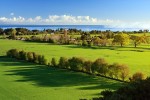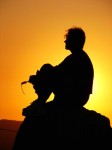 The direction of light describes where the light source is in relationship to you and your subject. It can change the look of your subject dramatically and therefore requires you to adjust your metering techniques somewhat. In the sections that follow, What follows is a description of light based on the direction it’s coming from and make some suggestions for using it.
The direction of light describes where the light source is in relationship to you and your subject. It can change the look of your subject dramatically and therefore requires you to adjust your metering techniques somewhat. In the sections that follow, What follows is a description of light based on the direction it’s coming from and make some suggestions for using it.
How you choose to use the direction of light depends on which of the attributes of that particular light may or may not suit your purpose for a given image
Frontlight
You have frontlight when the light source is on the same side of your subject as you are, like when the sun is behind you or when the flash on your camera goes off.
Following are the characteristics of frontlight:
- It’s very even.
- It doesn’t add contrast to the subject.
- It shows colors and shapes well (unless the shapes are three-dimensional).
- It’s good for a variations in subject tonality.
- It usually minimizes texture.
- It can make subjects look flat and two-dimensional.
- It can be boring unless you have a subject with strong variations in color or tonality.
Frontlight isn’t great in all situations, but when it’s soft, it’s the best light for minimizing imperfections in human skin. (Now you know why they put that huge light in front of you when you got your school pictures back in the day.)
Avoid taking photos of people when they’re facing the sun. It may be frontlight, but it’s too harsh.
Even though the majority of people take lots of front-lit photos, you’ll be a better photographer, hone your exposure skills more quickly, and have more dramatic images if you take a higher percentage of backlit and side-lit photos.
Sidelight
If the sun or light source is to the side of your subject, you have sidelight – half the subject is lit and half is in shadow. The mix of light and shadow increases the contrast in the subject. The characteristics of sidelight are as follows:
- It’s dramatic.
- It can cast long shadows when the sun is low in the sky.
- It makes subjects more three-dimensional.
- It’s great at revealing texture.
- It can reduce the amount of color information.
- It’s harder to meter than frontlight.
Landscape photographers love sidelight, especially warm sidelight when the sun is low across the sky, because it creates long shadows across the frame.
Some subjects tend to lack color interest, but they really pop with the contrast between light and shadow that sidelight creates.
Backlight
You have backlight when the sun or other light source is behind your subject. It’s bold and dramatic, but it’s also a challenge to work with. Never fear, though. The photos you get when you use backlight are totally worth it.
 Following are the characteristics of backlight:
Following are the characteristics of backlight:
- It creates dramatic contrast.
- It can significantly reduce the color information in your subject.
- It emphasizes shapes (so it’s better for when you want shapes to take priority over color).
- It can create dramatic rim lighting (a bright halo of light around your subject) when the sun is directly behind the subject.
- It creates a fresh look because most people rarely try backlighting.
- It can be used to create silhouettes.
- It darkens unlit areas of the subject.
- It’s the most challenging type of light meter.